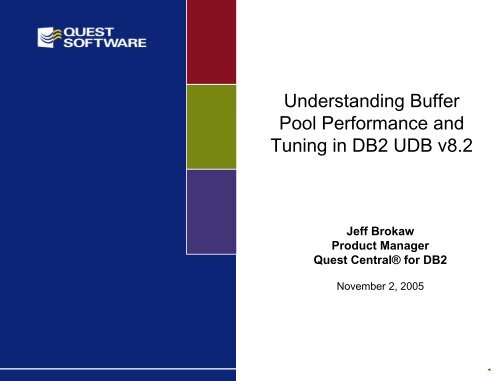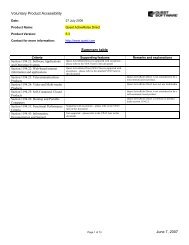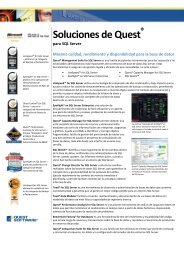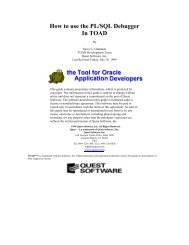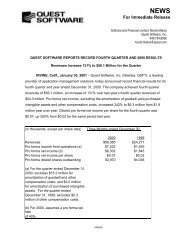Understanding Buffer Pool Performance and ... - Quest Software
Understanding Buffer Pool Performance and ... - Quest Software
Understanding Buffer Pool Performance and ... - Quest Software
Create successful ePaper yourself
Turn your PDF publications into a flip-book with our unique Google optimized e-Paper software.
<strong>Underst<strong>and</strong>ing</strong> <strong>Buffer</strong><br />
<strong>Pool</strong> <strong>Performance</strong> <strong>and</strong><br />
Tuning in DB2 UDB v8.2<br />
Jeff Brokaw<br />
Product Manager<br />
<strong>Quest</strong> Central® for DB2<br />
November 2, 2005
Agenda<br />
• <strong>Buffer</strong> pool overview<br />
• <strong>Buffer</strong> pool management<br />
• Collecting performance metrics<br />
• Evaluating performance metrics<br />
– Physical vs. logical IO<br />
– Asynchronous vs. synchronous IO<br />
– Page cleaner tuning<br />
• Q&A<br />
You Can Expect More
Introduction<br />
You Can Expect More<br />
Q: With so many tuning areas to focus on why should we pay<br />
special attention to the buffer pool?<br />
A: DB2 uses the buffer pool to offset the performance disparity<br />
between CPU <strong>and</strong> disk, so they are vital for optimizing<br />
transaction throughput. From the 8.2 Admin Guide:<br />
<strong>Performance</strong> (emphasis mine):<br />
“Because most data manipulation takes place in buffer pools,<br />
configuring buffer pools is the single most important tuning area.”
You Are Here – DB2 Process Model<br />
Listener<br />
Client<br />
Application<br />
Coordinator<br />
Subagents<br />
Prefetchers<br />
<strong>Buffer</strong> <strong>Pool</strong><br />
Logger<br />
You Can Expect More<br />
External<br />
Storage<br />
Page<br />
Cleaners<br />
Log
<strong>Buffer</strong> <strong>Pool</strong> Overview<br />
Basics <strong>and</strong> Terminology<br />
You Can Expect More<br />
• Area of memory into which database pages are read,<br />
modified, <strong>and</strong> held during processing<br />
– A hit occurs when required page is found in buffer pool<br />
– A miss occurs when required page not found in buffer pool<br />
• Pages in buffer pool exist in one of three states:<br />
1. In use<br />
2. Dirty<br />
3. Clean
<strong>Buffer</strong> <strong>Pool</strong> Overview<br />
Basics <strong>and</strong> Terminology (cont’d)<br />
• Pages read into buffer pool from disk by:<br />
– Agents, using synchronous I/O<br />
– Prefetchers, using asynchronous I/O<br />
• Pages written to disk from buffer pool by:<br />
– Agents, using synchronous I/O<br />
– Page cleaners, using asynchronous I/O<br />
You Can Expect More
<strong>Buffer</strong> <strong>Pool</strong> Overview<br />
Tuning Goals<br />
• Recovery vs. <strong>Performance</strong><br />
– Recovery wants everything on disk<br />
– Database manager wants everything in memory<br />
– Which goal is more important – largely depends on data<br />
– Which combination works best for both goals<br />
You Can Expect More<br />
• High hit ratio means logical reads usually successful,<br />
avoiding disk access<br />
• Normally want to maximize asynchronous I/O to minimize<br />
waits
<strong>Buffer</strong> <strong>Pool</strong> Overview<br />
You Can Expect More<br />
Prefetchers <strong>and</strong> Page Cleaners<br />
• DB2 uses prefetch <strong>and</strong> page cleaner processes to reduce<br />
the time that agents have to wait for IO operations to<br />
complete<br />
• New in 8.1.4: Proactive Page Cleaning, AKA Alternate<br />
Page Cleaning<br />
– DB2_USE_ALTERNATE_PAGE_CLEANING=ON
<strong>Buffer</strong> <strong>Pool</strong> Overview<br />
Prefetch<br />
You Can Expect More<br />
• Prefetchers try to ensure that agents doing tablespace<br />
scans never wait for disk I/O<br />
• Agents send asynchronous read-ahead request to common<br />
prefetch queue<br />
• Prefetchers service the request by bringing the requested<br />
pages into the buffer pool<br />
• Should result in logical read, drive hit rate up<br />
• Two types:<br />
– List prefetch, efficiently reads a set of non-consecutive data pages<br />
– Sequential prefetch, reads consecutive pages
<strong>Buffer</strong> <strong>Pool</strong> Overview<br />
You Can Expect More<br />
Page Cleaners<br />
• Two main goals<br />
– Ensure that agents reading a page into the buffer pool never<br />
need to first flush a dirty page to disk to free up a slot<br />
– Speed recovery time by reducing # log files needed<br />
• Configuration parameters<br />
– num_iocleaners – number of page cleaners for a database<br />
– chngpgs_thresh – percentage of changed pages at which the page<br />
cleaners will be started, if not currently active<br />
• Alternate page cleaning (8.1.4 <strong>and</strong> later)<br />
– List of “good victim pages” (dirty pages just written out) kept,<br />
prevents searching in many cases<br />
– LSN gaps anticipated, prevents I/O spikes<br />
– chngpgs_thresh is ignored
You Are Here – DB2 Process Model<br />
Listener<br />
Client<br />
Application<br />
Coordinator<br />
Subagents<br />
Prefetchers<br />
<strong>Buffer</strong> <strong>Pool</strong><br />
Logger<br />
You Can Expect More<br />
External<br />
Storage<br />
Page<br />
Cleaners<br />
Log
<strong>Buffer</strong> <strong>Pool</strong> Management<br />
<strong>Buffer</strong> pools not used with all data types<br />
You Can Expect More<br />
• LONG VARCHAR, BLOB <strong>and</strong> CLOB retrieved directly from<br />
disk using non-buffered (direct) IO<br />
• Keeping large object pages out of buffer pools helps DB2<br />
maintain effective caching for regular data types<br />
1 GB BLOB 1 GB BP Disk<br />
Without use of direct IO,<br />
large data types would<br />
force DB2 to flush all<br />
resident pages to disk –<br />
ruining the hit rate
<strong>Buffer</strong> <strong>Pool</strong> Management<br />
You Can Expect More<br />
Creating/Altering <strong>Buffer</strong> <strong>Pool</strong>s<br />
• IBMDEFAULTBP automatically created with each database<br />
• Additional buffer pools added with the CREATE<br />
BUFFERPOOL statement<br />
• SYSCTRL or SYSADM privileges are required to work with<br />
buffer pools<br />
CREATE BUFFERPOOL bufferpool_name SIZE number of pages<br />
[IMMEDIATE | DEFERRED]<br />
[PAGESIZE integer [K]]<br />
[[NOT] EXTENDED STORAGE<br />
| NUMBLOCKPAGES number of pages [BLOCKSIZE number of pages]]<br />
[ALL DBPARTITIONNUMS<br />
| DATABASE PARTITION GROUP db_partition_group_name [,…]]<br />
[EXCEPT ON DBPARTITIONNUM[S] (db_partition_number1 [TO db_partition_number2]<br />
SIZE number of pages [,…])]
<strong>Buffer</strong> <strong>Pool</strong> Management<br />
Memory Usage<br />
You Can Expect More<br />
• Version 8 makes DB2 easier to manage by using database<br />
global memory (DATABASE_MEMORY) instead of database<br />
heap (DBHEAP)<br />
• Prevents resizing of DBHEAP with bufferpool resizing<br />
CREATE BUFFERPOOL bufferpool_name SIZE number of pages<br />
[IMMEDIATE | DEFERRED]<br />
[PAGESIZE integer [K]]<br />
[[NOT] EXTENDED STORAGE<br />
| NUMBLOCKPAGES number of pages [BLOCKSIZE number of pages]]<br />
[ALL DBPARTITIONNUMS<br />
| DATABASE PARTITION GROUP db_partition_group_name [,…]]<br />
[EXCEPT ON DBPARTITIONNUM[S] (db_partition_number1 [TO db_partition_number2]<br />
SIZE number of pages [,…])]
<strong>Buffer</strong> <strong>Pool</strong> Management<br />
You Can Expect More<br />
Extended Storage<br />
• 32-bit DB2 can’t support creating buffer pools larger than<br />
4G due to addressable storage limits<br />
• Extended storage allows DB2 to flush dirty pages to<br />
memory rather than disk, so future access to the pages is<br />
much faster<br />
• Requires NUM_ESTORE_SEGS <strong>and</strong> ESTORE_SEG_SIZE<br />
configuration parameters<br />
CREATE BUFFERPOOL bufferpool_name SIZE number of pages<br />
[IMMEDIATE | DEFERRED]<br />
[PAGESIZE integer [K]]<br />
[[NOT] EXTENDED STORAGE<br />
| NUMBLOCKPAGES number of pages [BLOCKSIZE number of pages]]<br />
[ALL DBPARTITIONNUMS<br />
| DATABASE PARTITION GROUP db_partition_group_name [,…]]<br />
[EXCEPT ON DBPARTITIONNUM[S] (db_partition_number1 [TO db_partition_number2]<br />
SIZE number of pages [,…])]
<strong>Buffer</strong> <strong>Pool</strong> Management<br />
Block-Based <strong>Buffer</strong> <strong>Pool</strong>s<br />
You Can Expect More<br />
• Contiguous blocks of pages to be moved into contiguous<br />
portions of memory<br />
• Block-based buffer pools will be wasted if your application<br />
doesn’t perform sequential prefetch<br />
CREATE BUFFERPOOL bufferpool_name SIZE number of pages<br />
[IMMEDIATE | DEFERRED]<br />
[PAGESIZE integer [K]]<br />
[[NOT] EXTENDED STORAGE<br />
| NUMBLOCKPAGES number of pages [BLOCKSIZE number of pages]]<br />
[ALL DBPARTITIONNUMS<br />
| DATABASE PARTITION GROUP db_partition_group_name [,…]]<br />
[EXCEPT ON DBPARTITIONNUM[S] (db_partition_number1 [TO db_partition_number2]<br />
SIZE number of pages [,…])]
<strong>Buffer</strong> <strong>Pool</strong> Management<br />
You Can Expect More<br />
Hidden <strong>Buffer</strong> <strong>Pool</strong>s<br />
• For improved availability only<br />
• DB2 creates small (16 page) buffer pools of each page size<br />
at database activation (4, 8, 16, 32k)<br />
• Hidden from the user, <strong>and</strong> used only when ordinary buffer<br />
pools cannot be allocated<br />
• <strong>Performance</strong> will be noticeably impacted, <strong>and</strong> DB2 will write<br />
a warning message to the administration notification log
<strong>Buffer</strong> <strong>Pool</strong> Management<br />
You Can Expect More<br />
Related Objects<br />
• CREATE TABLESPACE specifies which buffer pool to use<br />
• Page sizes of buffer pool <strong>and</strong> tablespace must match –<br />
valid values are 4, 8, 16, <strong>and</strong> 32 kilobytes<br />
• CREATE BUFFERPOOL statement can specify partition<br />
group, to control partitions in which a given buffer pool is<br />
created
Collecting <strong>Performance</strong> Metrics<br />
Tuning – An Iterative Process<br />
• Collect performance data<br />
– Snapshot monitoring<br />
– Event monitoring<br />
• Review the results<br />
– Underst<strong>and</strong> SQL workload<br />
– Evaluate performance (calculations)<br />
• Take action<br />
– Resize buffer pools<br />
– Define more page cleaners<br />
– Break out tables with “like” workloads<br />
• Start the process again<br />
You Can Expect More
Collecting <strong>Performance</strong> Metrics<br />
Snapshot monitor Event Monitor<br />
You Can Expect More<br />
“Point in time” representation of data “Event” based representation of data<br />
Less overhead (~5%) More overhead (~10-20%)<br />
Need to reissue over time “Create” it once <strong>and</strong> it runs until it’s<br />
told to stop<br />
Monitor Switches need to be turned<br />
on to collect data<br />
“Real time” balance of application<br />
<strong>and</strong> database performance<br />
“Create” takes care of everything<br />
“Historical” main focus on<br />
Application statistics
Collecting <strong>Performance</strong> Metrics<br />
DB2 Snapshot Switches<br />
• Seven Switches<br />
– <strong>Buffer</strong> <strong>Pool</strong> (dft_mon_bufpool)<br />
– Lock (dft_mon_lock)<br />
– Sort (dft_mon_sort)<br />
– Statement (dft_mon_stmt)<br />
– Unit of Work (dft_mon_uow)<br />
– Table (dft_mon_table)<br />
– Timestamp (dft_mon_timestamp)<br />
You Can Expect More
Collecting <strong>Performance</strong> Metrics<br />
You Can Expect More<br />
DB2 Snapshot Switches (cont’d)<br />
• Turning switches on at the instance – take care here<br />
UPDATE DATABASE MANAGER CONFIGURATION USING<br />
dft_mon_bufpool ON<br />
dft_mon_lock ON<br />
dft_mon_sort ON<br />
dft_mon_stmt ON<br />
dft_mon_table ON<br />
dft_mon_uow ON<br />
IMMEDIATE<br />
• Turning switches on for session<br />
UPDATE MONITOR SWITCHES USING bufferpool ON
Collecting <strong>Performance</strong> Metrics<br />
• Issuing a SNAPSHOT request<br />
– Instance level (requires “ATTACH”)<br />
• For all active databases<br />
GET SNAPSHOT FOR ALL BUFFERPOOLS<br />
• For a specific database<br />
GET SNAPSHOT FOR BUFFERPOOLS ON database_name<br />
• For a specific database partition<br />
GET SNAPSHOT FOR BUFFERPOOLS ON database_name<br />
AT DBPARTITIONNUM db_partition_number<br />
You Can Expect More<br />
• BUFFERPOOL <strong>and</strong> DATABASE snapshot calls are<br />
essential for tuning buffer pools
Collecting <strong>Performance</strong> Metrics<br />
• BUFFERPOOL Snapshot<br />
<strong>Buffer</strong>pool name = BASEBP1<br />
Database name = BASEBALL<br />
Database path =<br />
C:\DB2\NODE0000\SQL00005\<br />
Input database alias = BASEBALL<br />
<strong>Buffer</strong> pool data logical reads = 300<br />
<strong>Buffer</strong> pool data physical reads = 3490<br />
<strong>Buffer</strong> pool data writes = 3050<br />
<strong>Buffer</strong> pool index logical reads = 67<br />
<strong>Buffer</strong> pool index physical reads = 34<br />
.<br />
.<br />
.<br />
Node number = 0<br />
Tablespaces using bufferpool = 4<br />
Alter bufferpool information:<br />
Pages left to remove = 0<br />
Current size = 1000<br />
Post-alter size = 1000<br />
You Can Expect More
Collecting <strong>Performance</strong> Metrics<br />
• DATABASE Snapshot<br />
You Can Expect More<br />
Database name = AUTO_PRD<br />
Database path = C:\DB2\NODE0000\SQL00009\<br />
.<br />
.<br />
.<br />
<strong>Buffer</strong> pool data logical reads = 165079<br />
<strong>Buffer</strong> pool data physical reads = 36264<br />
Asynchronous pool data page reads = 10546<br />
<strong>Buffer</strong> pool data writes = 3991<br />
Asynchronous pool data page writes = 3873<br />
<strong>Buffer</strong> pool index logical reads = 4014<br />
<strong>Buffer</strong> pool index physical reads = 558<br />
Asynchronous pool index page reads = 332<br />
<strong>Buffer</strong> pool index writes = 26<br />
Asynchronous pool index page writes = 26<br />
Total buffer pool read time (ms) = 8329<br />
Total buffer pool write time (ms) = 121852<br />
Total elapsed asynchronous read time = 5353<br />
Total elapsed asynchronous write time = 121292<br />
Asynchronous read requests = 1681<br />
LSN Gap cleaner triggers = 24<br />
Dirty page steal cleaner triggers = 63<br />
Dirty page threshold cleaner triggers = 33<br />
Time waited for prefetch (ms) = 626
Evaluating <strong>Performance</strong> Metrics<br />
Know your workload<br />
• Is the SQL workload primarily:<br />
– Update/Insert/Delete (OLTP)<br />
– Select (ad hoc, data warehouse)<br />
• Event Monitoring can help if unsure<br />
You Can Expect More
Evaluating <strong>Performance</strong> Metrics<br />
You Can Expect More<br />
Logical IO vs. physical IO – minimize number of times DB2<br />
must access physical disks<br />
Key I/O Metrics:<br />
– Overall hit rate<br />
– Data hit rate<br />
– Index hit rate<br />
– Physical IO read rate
Evaluating <strong>Performance</strong> Metrics<br />
Overall Hit Rate<br />
You Can Expect More<br />
– Includes all data <strong>and</strong> index reads into buffer pool<br />
⎡<br />
⎤<br />
⎢<br />
⎥<br />
( . . . . . . )<br />
Buffe<strong>Pool</strong>OHR<br />
⎢ bp datalogical<br />
reads+<br />
bp indexlogical<br />
reads ⎥<br />
<strong>Buffer</strong>poolOHR<br />
=<br />
* 100<br />
⎢⎛bp.<br />
index.<br />
logical.<br />
reads+<br />
bp.<br />
index.<br />
physical.<br />
reads+<br />
⎞⎥<br />
⎢⎜<br />
⎟⎥<br />
⎣⎝bp.<br />
data.<br />
logical.<br />
reads+<br />
bp.<br />
data.<br />
physical.<br />
reads ⎠⎦<br />
– Low values = more physical IO<br />
– High values = more logical IO<br />
– 85 – 90% is a good starting point
Evaluating <strong>Performance</strong> Metrics<br />
Data Hit Rate<br />
– Includes all data reads into buffer pool<br />
<strong>Buffer</strong>pool<br />
DHR<br />
=<br />
⎛<br />
⎜<br />
⎝<br />
– Low values = more physical IO<br />
– High values = more logical IO<br />
– 85 – 90% is a good starting point<br />
You Can Expect More<br />
bp.<br />
data.<br />
logical . reads<br />
bp.<br />
data.<br />
logical . reads + bp.<br />
data.<br />
physical . reads<br />
⎞<br />
⎟*<br />
100<br />
⎠
Evaluating <strong>Performance</strong> Metrics<br />
Index Hit Rate<br />
– Includes all index reads by buffer pool<br />
<strong>Buffer</strong>pool<br />
IHR<br />
=<br />
⎛<br />
⎜<br />
⎝<br />
– Low values = more physical IO<br />
– High values = more logical IO<br />
– 85 – 90% is a good starting point<br />
You Can Expect More<br />
bp.<br />
index.<br />
logical . reads<br />
bp.<br />
index.<br />
logical . reads + bp.<br />
index.<br />
physical . reads<br />
⎞<br />
⎟ * 100<br />
⎠
Evaluating <strong>Performance</strong> Metrics<br />
Physical IO Read Rate<br />
PhysicalIOReads<br />
=<br />
⎛ bufferpool.<br />
data.<br />
logical.<br />
reads + bufferpool.<br />
data.<br />
⎜<br />
⎝<br />
total.<br />
collection.<br />
time<br />
You Can Expect More<br />
• Total number of physical reads by buffer pool over time<br />
• Use:<br />
GET SNAPSHOT FOR TABLESPACES ON database_name<br />
• Could indicate the need for…<br />
– Additional containers<br />
– <strong>Buffer</strong> pool breakout<br />
physical.<br />
reads<br />
⎞<br />
⎟<br />
⎠
Evaluating <strong>Performance</strong> Metrics<br />
Prefetch – Asynchronous vs. Synchronous I/O<br />
– Waiting is always bad<br />
You Can Expect More<br />
– Make DB2 read ahead for you as much as possible,<br />
given application mix<br />
Approach:<br />
– Evaluate prefetch ratio<br />
– Know the workload<br />
– Evaluate prefetcher configuration<br />
– Use block I/O
Evaluating <strong>Performance</strong> Metrics<br />
Prefetch Ratio<br />
PrefetchRatio<br />
=<br />
⎛<br />
⎜<br />
⎝<br />
async.pool.data.reads<br />
bp.logical.reads<br />
• Lower values = more synchronous<br />
• Higher values = more asynchronous<br />
• Are there enough defined?<br />
+<br />
+<br />
You Can Expect More<br />
async.pool.index.reads<br />
bp.index.logical.reads<br />
⎞<br />
⎟*<br />
100<br />
⎠
Evaluating <strong>Performance</strong> Metrics<br />
Block-based <strong>Buffer</strong> <strong>Pool</strong>s<br />
You Can Expect More<br />
– If using sequential prefetch, enable buffer pools to utilize<br />
block IO<br />
ALTER BUFFERPOOL basebp2 NUMBLOCKPAGES 30;<br />
ALTER BUFFERPOOL basebp2 BLOCKSIZE 10;<br />
– NUMBLOCKPAGES should be a multiple of block size
Evaluating <strong>Performance</strong> Metrics<br />
Evaluating Page Cleaner <strong>Performance</strong>:<br />
– LSN Gap Triggers<br />
– Dirty Page Threshold Triggers<br />
– Dirty Page Steal Triggers<br />
You Can Expect More<br />
Approach:<br />
– Evaluate workload <strong>and</strong> recovery goals<br />
– Evaluate each metric against all others<br />
– Modify parameters influencing page cleaner activity<br />
– Enough page cleaners defined?<br />
– More automated in V8.1.4 <strong>and</strong> above
Evaluating <strong>Performance</strong> Metrics<br />
LCR<br />
Log Cleans Ratio<br />
You Can Expect More<br />
⎛<br />
⎞<br />
⎜<br />
⎟<br />
⎜<br />
lsn.<br />
gap.<br />
cleaner.<br />
triggers<br />
⎟<br />
= ⎜<br />
* 100<br />
⎛ dirt.<br />
page.<br />
steal.<br />
cleaner.<br />
triggers + lsn.<br />
gap.<br />
cleaner.<br />
triggers ⎞<br />
⎟<br />
⎜<br />
⎟<br />
⎜<br />
⎜<br />
⎟<br />
. . . .<br />
⎟<br />
⎝ ⎝ + dirty page threshold cleaners triggers ⎠ ⎠<br />
– Has an affect on recovery times<br />
– Too small or too large could be detrimental to buffer<br />
pool performance<br />
– Affected by SOFTMAX DB CONFIG parameter<br />
– 0 if ALTERNATE_PAGE_CLEANING=ON
Evaluating <strong>Performance</strong> Metrics<br />
TCR<br />
Threshold Cleans Ratio<br />
– CHNGPGS_THRESH DB CONFIG parameter<br />
– Finding a “happy medium” is key<br />
– 0 if ALTERNATE_PAGE_CLEANING=ON<br />
You Can Expect More<br />
⎛<br />
⎞<br />
⎜<br />
⎟<br />
⎜ dirty.<br />
page.<br />
threshold . cleaner.<br />
triggers ⎟<br />
= ⎜<br />
* 100<br />
⎛ dirt.<br />
page.<br />
steal.<br />
cleaner.<br />
triggers + lsn.<br />
gap.<br />
cleaner.<br />
triggers ⎞<br />
⎟<br />
⎜<br />
⎟<br />
⎜<br />
⎜<br />
⎟<br />
. . . .<br />
⎟<br />
⎝ ⎝ + dirty page threshold cleaner triggers ⎠ ⎠
Evaluating <strong>Performance</strong> Metrics<br />
VCR<br />
Victim Cleans Ratio<br />
You Can Expect More<br />
⎛<br />
⎞<br />
⎜<br />
⎟<br />
⎜<br />
dirty.<br />
page.<br />
steal.<br />
cleaner.<br />
triggers<br />
⎟<br />
= ⎜<br />
* 100<br />
⎛ dirt.<br />
page.<br />
steal.<br />
cleaner.<br />
triggers + lsn.<br />
gap.<br />
cleaner.<br />
triggers ⎞<br />
⎟<br />
⎜<br />
⎟<br />
⎜<br />
⎜<br />
⎟<br />
. . . .<br />
⎟<br />
⎝ ⎝ + dirty page threshold cleaner triggers ⎠ ⎠<br />
– Above 40%, typically means buffer pool needs to be<br />
larger<br />
– Could also mean SOFTMAX parameter is too high<br />
(not enough page turnover)<br />
– 0 if ALTERNATE_PAGE_CLEANING=ON
Conclusion<br />
You Can Expect More<br />
• Focus on three main areas<br />
1. BP hit ratios (logical vs. physical)<br />
2. Prefetcher tuning (asynchronous vs. synchronous)<br />
3. Page cleaner tuning (if not using newer alternate cleaning)<br />
• Collect performance data over time<br />
– Sampling methodology – snapshots every 5-15 minutes over the<br />
course of the day, or during a batch run<br />
• Review the results<br />
– Decipher data <strong>and</strong> plug into equations<br />
– Know the workload<br />
– Chart performance over time<br />
• Take action<br />
– Various solutions depending on findings
<strong>Quest</strong> <strong>Software</strong>: You Can Expect More<br />
http://www.quest.com/db2/<br />
You Can Expect More


